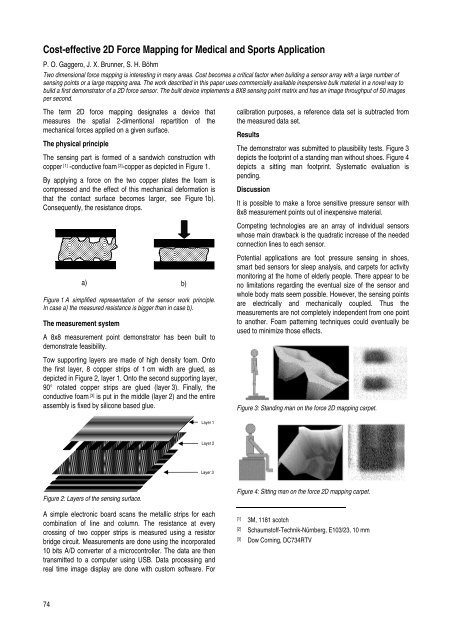CSEM Scientific and Technical Report 2008
CSEM Scientific and Technical Report 2008
CSEM Scientific and Technical Report 2008
Create successful ePaper yourself
Turn your PDF publications into a flip-book with our unique Google optimized e-Paper software.
Cost-effective 2D Force Mapping for Medical <strong>and</strong> Sports Application<br />
P. O. Gaggero, J. X. Brunner, S. H. Böhm<br />
Two dimensional force mapping is interesting in many areas. Cost becomes a critical factor when building a sensor array with a large number of<br />
sensing points or a large mapping area. The work described in this paper uses commercially available inexpensive bulk material in a novel way to<br />
build a first demonstrator of a 2D force sensor. The built device implements a 8X8 sensing point matrix <strong>and</strong> has an image throughput of 50 images<br />
per second.<br />
The term 2D force mapping designates a device that<br />
measures the spatial 2-dimentional repartition of the<br />
mechanical forces applied on a given surface.<br />
The physical principle<br />
The sensing part is formed of a s<strong>and</strong>wich construction with<br />
copper [1] -conductive foam [2] -copper as depicted in Figure 1.<br />
By applying a force on the two copper plates the foam is<br />
compressed <strong>and</strong> the effect of this mechanical deformation is<br />
that the contact surface becomes larger, see Figure 1b).<br />
Consequently, the resistance drops.<br />
Figure 1 A simplified representation of the sensor work principle.<br />
In case a) the measured resistance is bigger than in case b).<br />
The measurement system<br />
A 8x8 measurement point demonstrator has been built to<br />
demonstrate feasibility.<br />
Tow supporting layers are made of high density foam. Onto<br />
the first layer, 8 copper strips of 1 cm width are glued, as<br />
depicted in Figure 2, layer 1. Onto the second supporting layer,<br />
90° rotated copper strips are glued (layer 3). Finally, the<br />
conductive foam [3] is put in the middle (layer 2) <strong>and</strong> the entire<br />
assembly is fixed by silicone based glue.<br />
Figure 2: Layers of the sensing surface.<br />
A simple electronic board scans the metallic strips for each<br />
combination of line <strong>and</strong> column. The resistance at every<br />
crossing of two copper strips is measured using a resistor<br />
bridge circuit. Measurements are done using the incorporated<br />
10 bits A/D converter of a microcontroller. The data are then<br />
transmitted to a computer using USB. Data processing <strong>and</strong><br />
real time image display are done with custom software. For<br />
74<br />
a) b)<br />
Layer 1<br />
Layer 2<br />
Layer 3<br />
calibration purposes, a reference data set is subtracted from<br />
the measured data set.<br />
Results<br />
The demonstrator was submitted to plausibility tests. Figure 3<br />
depicts the footprint of a st<strong>and</strong>ing man without shoes. Figure 4<br />
depicts a sitting man footprint. Systematic evaluation is<br />
pending.<br />
Discussion<br />
It is possible to make a force sensitive pressure sensor with<br />
8x8 measurement points out of inexpensive material.<br />
Competing technologies are an array of individual sensors<br />
whose main drawback is the quadratic increase of the needed<br />
connection lines to each sensor.<br />
Potential applications are foot pressure sensing in shoes,<br />
smart bed sensors for sleep analysis, <strong>and</strong> carpets for activity<br />
monitoring at the home of elderly people. There appear to be<br />
no limitations regarding the eventual size of the sensor <strong>and</strong><br />
whole body mats seem possible. However, the sensing points<br />
are electrically <strong>and</strong> mechanically coupled. Thus the<br />
measurements are not completely independent from one point<br />
to another. Foam patterning techniques could eventually be<br />
used to minimize those effects.<br />
Figure 3: St<strong>and</strong>ing man on the force 2D mapping carpet.<br />
Figure 4: Sitting man on the force 2D mapping carpet.<br />
[1] 3M, 1181 scotch<br />
[2] Schaumstoff-Technik-Nürnberg, E103/23, 10 mm<br />
[3] Dow Corning, DC734RTV








